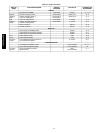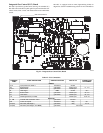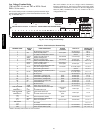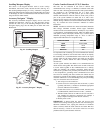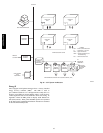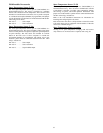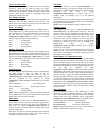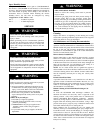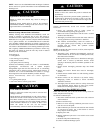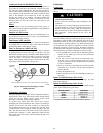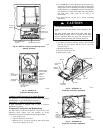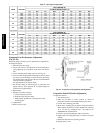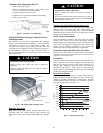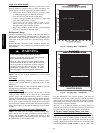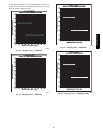
82
Space Humidity Sensor
The space relative humidity sensor (part no. 33ZCSENDRH−01
duct mount or 33ZCSENSRH−01 wall mount) is a field−installed
accessory. The space relative humidity (RHS) may be selected for
use if the outdoor air quality sensor (OAQ) is not used and an
economizer board is installed. When installing the relative
humidity sensor, the unit must be configured by setting
Configuration→UNIT→RH.S to YES.
TB−1 24 VDC Loop Power..........
TB−44−20mA Input Signal..........
SERVICE
ELECTRICAL SHOCK HAZARD
Failure to follow this warning could cause personal
injury or death.
Before performing service or maintenance operations
on unit, turn off main power switch to unit and install
lockout tag. Ensure electrical service to rooftop unit
agrees with voltage and amperage listed on the unit
rating plate.
!
WARNING
UNIT OPERATION AND SAFETY HAZARD
Failure to follow this warning could cause personal
injury, death and/or equipment damage.
Puron (R−410A) refrigerant systems operate at higher
pressures than standard R−22 systems. Do not use R−22
service equipment or components on Puron refrigerant
equipment.
!
WARNING
FIRE, EXPLOSION HAZARD
Failure to follow this warning could result in personal
injury, death and/or property damage.
1. Improper installation, adjustment, alteration, service,
or maintenance can cause property damage, personal
injury, or loss of life. Refer to the User’s Information
Manual provided with this unit for more details.
2. Do not store or use gasoline or other flammable
vapors and liquids in the vicinity of this or any other
appliance.
What to do if you smell gas:
1. DO NOT try to light any appliance.
2. DO NOT touch any electrical switch, or use any
phone in your building.
3. IMMEDIATELY call your gas supplier from a
neighbor’s phone. Follow the gas supplier’s
instructions.
4. If you cannot reach your gas supplier, call the fire
department.
!
WARNING
FIRE, EXPLOSION HAZARD
Failure to follow this warning could result in personal
injury or death.
Disconnect gas piping from unit when pressure testing at
pressure greater than 0.5 psig. Pressures greater than
0.5 psig will cause gas valve damage resulting in hazardous
condition. If gas valve is subjected to pressure greater than
0.5 psig, it must be replaced before use. When pressure
testing field-supplied gas piping at pressures of 0.5 psig or
less, a unit connected to such piping must be isolated by
closing the manual gas valve(s).
!
WARNING
Cleaning
Inspect unit interior at beginning of each heating and cooling
season and as operating conditions require. Remove unit top panel
and/or side panels for access to unit interior.
Coil Maintenance and Cleaning Recommendation
Routine cleaning of coil surfaces is essential to maintain proper
operation of the unit. Elimination of contamination and removal of
harmful residues will greatly increase the life of the coil and extend
the life of the unit. The following maintenance and cleaning
procedures are recommended as part of the routine maintenance
activities to extend the life of the coil.
Remove Surface Loaded Fibers
Surface loaded fibers or dirt should be removed with a vacuum
cleaner. If a vacuum cleaner is not available, a soft non-metallic
bristle brush may be used. In either case, the tool should be applied
in the direction of the fins. Coil surfaces can be easily damaged (fin
edges can be easily bent over and damage to the coating of a
protected coil) if the tool is applied across the fins.
NOTE: Use of a water stream, such as a garden hose, against a
surface loaded coil will drive the fibers and dirt into the coil. This
will make cleaning efforts more difficult. Surface loaded fibers
must be completely removed prior to using low velocity clean
water rinse.
Periodic Clean Water Rinse
A periodic clean water rinse is very beneficial for coils that are
applied in coastal or industrial environments. However, it is very
important that the water rinse is made with very low velocity water
stream to avoid damaging the fin edges. Monthly cleaning as
described below is recommended.
Routine Cleaning of NOVATION Heat Exchanger Coil
Surfaces
To clean the NOVATION Heat Exchanger condenser coil,
chemicals are NOT to be used; only water is approved as the
cleaning solution. Only clean portable water is authorized for
cleaning NOVATION Heat Exchanger condensers. Carefully
remove any foreign objects or debris attached to the coil face or
trapped within the mounting frame and brackets. Using a high
pressure water sprayer, purge any soap or industrial cleaners from
hose and/or dilution tank prior to wetting the coil.
Clean condenser face by spraying the coil core steadily and
uniformly from top to bottom directing the spray straight into or
toward the coil face. Do not exceed 900 psig or a 45 degree angle;
nozzle must be at least 12” (30 cm) from the coil face. Reduce
pressure and use caution to prevent damage to air centers (fins). Do
not fracture the braze between air centers and refrigerant tubes.
Allow water to drain from the coil core and check for refrigerant
leaks prior to startup.
48/50PG and PM



